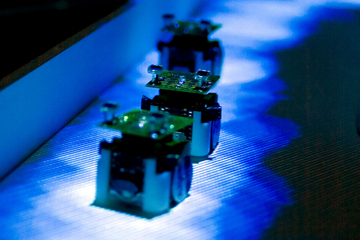
Robot swarms can mimic how ant colonies navigate complex mazes relatively mindlessly, researchers have found ― knowledge that could help to improve designs for manmade transportation networks.
 Scientists are fascinated by ant colonies because they can form collectives called "superorganisms" that function as single organisms do. Investigation into how ants behave has revealed more about how such group behavior arises, and some researchers are using that knowledge to help build smarter robot swarms, said Simon Garnier, a scientist who studies animal behavior at the New Jersey Institute of Technology.
Scientists are fascinated by ant colonies because they can form collectives called "superorganisms" that function as single organisms do. Investigation into how ants behave has revealed more about how such group behavior arises, and some researchers are using that knowledge to help build smarter robot swarms, said Simon Garnier, a scientist who studies animal behavior at the New Jersey Institute of Technology.
Scientists are making ants wander through mazes, just as they do with rats. These labyrinths mimic the twists and turns in ants' journeys between their nests and places rich in food.
Ants that reach a fork in a road usually follow the branch that diverges the least from the direction in which they came, recent studies have shown. This habit, combined with the chemical pheromone trails the ants leave behind, results in a greater chance that the ants will collectively pick the shortest, most direct route between their nest and food.
"Ants have 100,000 neurons ― less than we have in our fingers," Garnier said. "Despite that, they can form networks that help them navigate so much."
It was uncertain whether ants had or needed the brainpower to calculate which path deviated most from their original direction. Other ant experiments could not solve this mystery. However, "Since we can control the behavior of robots, we could use them to decide what information ants were using to navigate," Garnier said.
The researchers experimented with a swarm of sugar-cube-size antlike robots called "Alices." A camera followed the Alices' movements and used a video projector above the robots to lay down trails of light marking where the robots had traveled ― similar to the way real ants lay down chemical trails of pheromones.
The robots were programmed to follow light trails with a pair of light sensors, avoid obstacles and otherwise move forward ―randomly changing the angle at which they moved every few seconds. The robots lacked more sophisticated navigation techniques.
At the beginning of the experiment ― in which the branches of the maze had no light trail ― the robots simply moved forward at random angles. If the robots detected a light trail, they would follow that path.
This basic strategy naturally led the robots to choose the path that diverged least from their trajectory at each fork.
Garnier said. "If I were to blindfold you and make you walk straight down a corridor, if you arrived at a fork, hitting a wall, you would most likely push toward the path that deviated less."
"If you were to imagine water going down pipes, the same thing would happen," Garnier added. "If a pipe were to split, with one branch going in almost the same direction as the original pipe and one branch set at a big angle compared to the original pipe ―say 90 degrees ― more water would flow down the pipe that deviated less. The robots are just getting physically deflected."
The robots' behavior provides some insight into ants' cognitive abilities, Garnier said.
"The robots show that you don't need complex cognitive processes to navigate these mazes," Garnier said.
Although such research aimed only to answer questions about ant biology, it may be relevant to other applications.
"The principles that ants use to find shorter paths have actually been the basis of computer programs developed in the last 10 years to help decide what are the best paths for trucks to transport merchandise between cities ― the so-called traveling salesman problem," Garnier said. "One of the most efficient algorithms to solve this problem is directly inspired by the same logic studied in our work, and is also used by telecommunications companies to route packets of information between cell phones."

 Previous page
Previous page Back to top
Back to top







